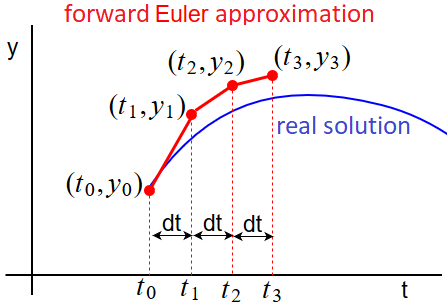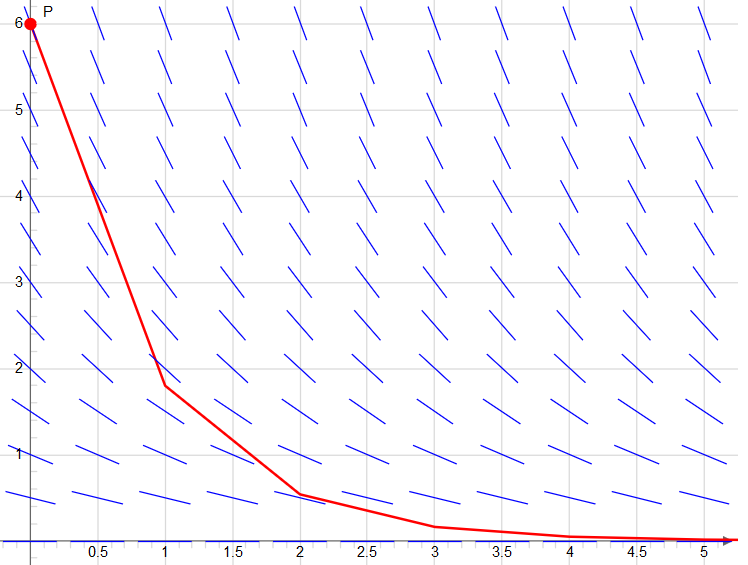Ordinary differential equations: Slope field and solution curves
 The forward Euler method
The forward Euler method
Forward Euler method The geometric approach to solving a first-order dynamical system of the form \[\frac{\dd y}{\dd t}=\varphi(t,y)\] with initial value \[y(t_0)=y_0\] via a slope field, according to the motto 'go with the flow', leads to the forward Euler method for computing a numerical solution a GDV.
Let \((t_0, y_0)\) be a point on the solution curve.
Suppose that you want to know the solution at time \(t_1=t_0+dt\) for some time step \(dt\).
If \(dt\) is small, you can approximate the graph of the function near \((t_0, y_0)\) by the tangent line \(y=y_0+y'(t_0)\cdot (t-t_0)=y_0+\varphi(t_0,y_0)\cdot (t-t_0)\).
Then you can approximate at \(t_1=t_0+dt\) the function value \(y(t_1)\) with \(y(t_1)\approx y_1= y_0+\varphi(t_0,y_0)\cdot dt\).
This method can be repeated with time \(t_2=t_1+dt\) and \(\bigl(t_1, y_1\bigr)\) as starting point.
Then: \(y(t_2)\approx y_2=y_1+\varphi(t_1,y_1)\cdot dt\).
One more time for \(t_3=t_2+dt\) and \(\bigl(t_2, y_2\bigr)\) as starting point.
Then: \(y(t_3)\approx y_3=y_2+\varphi(t_2,y_2)\cdot dt\).
You can continue this approximation process as long as you wish: \[t_k=t_0+k\cdot dt\quad\text{and}\quad y_{k+1}=y_k+\varphi(t_k,y_k)\cdot dt,\qquad\text{for }k=0,1,2,3,\ldots\]
The figure below shows how the approximations indeed differ from the actual solution curve, but for small steps \(dt\) the error will be limited.

In the figure below, the function values calculated for the initial value problem \(\frac{dy}{dt}=-0.7y,\; y(0)=6\) are shown in a line graph for the step size \(dt=1\).

Formula \(\eta_{k+1}=\eta_k+\varphi(t_k,\eta_k)\cdot dt\) is in this particular case equal to \[\eta_{k+1}=\eta_k+r\cdot \eta_k\cdot dt=\eta_k(1+r\cdot dt)=\eta_0(1+r\cdot dt)^{k+1}\] with \(r=-0.7, \eta_0=6\). The exact solution of this initial value problem is \(y(t)=6e^{-0.7t}\).
As the step size \(dt\) becomes smaller in the Euler method, the graph of the calculated function values becomes smoother and is increasingly more resemblant to the graph of an exact solution.


